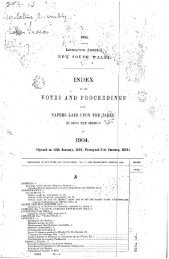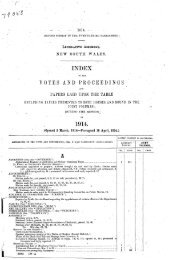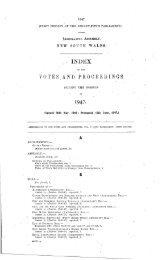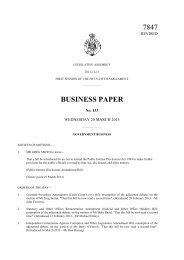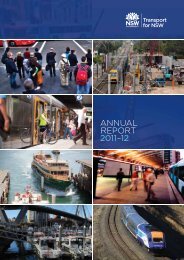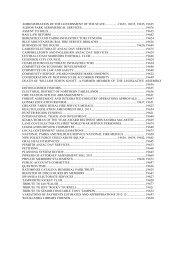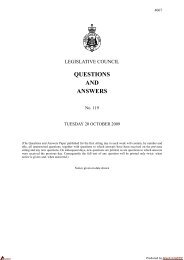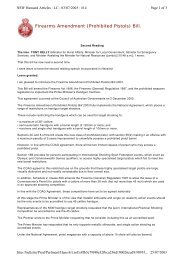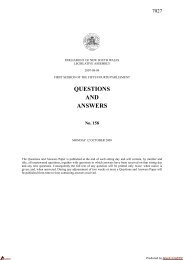Endeavour Energy Annual Performance Report - Parliament of New ...
Endeavour Energy Annual Performance Report - Parliament of New ...
Endeavour Energy Annual Performance Report - Parliament of New ...
Create successful ePaper yourself
Turn your PDF publications into a flip-book with our unique Google optimized e-Paper software.
09<br />
Financial<br />
statements<br />
Notes to the Financial Statements<br />
For the year ended 30 June 2011<br />
2 Statement <strong>of</strong> Significant<br />
Accounting Policies<br />
continued<br />
(i)<br />
Inventories<br />
Inventories are measured at the<br />
lower <strong>of</strong> cost and net realisable<br />
value. Costs incurred in bringing<br />
each product to its present location<br />
and condition are accounted for<br />
as follows:<br />
(i)<br />
(ii)<br />
Raw materials – purchase<br />
cost on weighted average<br />
cost basis; and<br />
Finished goods and workin-progress<br />
– cost <strong>of</strong> direct<br />
material, labour and a<br />
proportion <strong>of</strong> manufacturing<br />
overheads based on normal<br />
operating capacity.<br />
Net realisable value is the estimated<br />
selling price in the ordinary course<br />
<strong>of</strong> business, less the estimated costs<br />
<strong>of</strong> completion and selling costs.<br />
(j)<br />
Impairment<br />
Financial assets<br />
(including receivables)<br />
A financial asset not carried at<br />
fair value through pr<strong>of</strong>it or loss<br />
is assessed at each reporting<br />
date to determine whether there<br />
is objective evidence that it is<br />
impaired. A financial asset is<br />
impaired if objective evidence<br />
indicates that a loss event has<br />
occurred after the initial recognition<br />
<strong>of</strong> the asset, and that the loss<br />
event had a negative effect on the<br />
estimated future cash flows <strong>of</strong> that<br />
asset that can be estimated reliably.<br />
Impairment for receivables is<br />
generally considered at a collective<br />
level, however where objective<br />
evidence exists that a receivable<br />
is impaired, such as when a<br />
debtor ceases trading, individual<br />
significant receivables are assessed<br />
for impairment. In assessing<br />
collective impairment an estimate<br />
is made <strong>of</strong> probable non-payment<br />
based on historical trends and an<br />
assessment <strong>of</strong> current economic<br />
and credit conditions.<br />
An impairment loss in respect<br />
<strong>of</strong> a financial asset measured at<br />
amortised cost is calculated as the<br />
difference between its carrying<br />
amount and the present value <strong>of</strong><br />
the estimated future cash flows<br />
discounted at the asset’s original<br />
effective interest rate. Losses are<br />
recognised in pr<strong>of</strong>it or loss. When a<br />
subsequent event causes the amount<br />
<strong>of</strong> impairment loss to decrease,<br />
the decrease in impairment loss is<br />
reversed through pr<strong>of</strong>it or loss.<br />
Non-financial assets<br />
The carrying amounts <strong>of</strong> nonfinancial<br />
assets other than inventories<br />
and current tax receivable are<br />
reviewed at each reporting date<br />
to determine whether there is any<br />
indication <strong>of</strong> impairment, or when<br />
events or changes in circumstances<br />
indicate the carrying value may not<br />
be recoverable. If any such indication<br />
exists, then the asset’s recoverable<br />
amount is estimated.<br />
The recoverable amount <strong>of</strong> an asset<br />
or cash-generating unit (CGU) is<br />
the greater <strong>of</strong> its value in use and<br />
its fair value less costs to sell. In<br />
assessing value in use, the estimated<br />
future cash flows are discounted to<br />
their present value using a pre-tax<br />
discount rate that reflects current<br />
market assessments <strong>of</strong> the time<br />
value <strong>of</strong> money and the risks specific<br />
to the asset. For the purpose <strong>of</strong><br />
impairment testing, assets that<br />
cannot be tested individually are<br />
grouped together into the smallest<br />
group <strong>of</strong> asset that generates cash<br />
inflows from continuing use that are<br />
largely independent <strong>of</strong> cash inflows<br />
<strong>of</strong> other assets or groups <strong>of</strong> assets<br />
(the CGU).<br />
An impairment loss is recognised<br />
if the carrying amount <strong>of</strong> an asset<br />
or its CGU exceeds its estimated<br />
recoverable amount. Impairment<br />
losses are recognised in pr<strong>of</strong>it or<br />
loss where there is no corresponding<br />
entry in the Asset Revaluation<br />
Reserve. Impairment losses<br />
recognised in prior periods are<br />
assessed at each reporting date<br />
for any indications that the loss<br />
has decreased or no longer exists.<br />
An impairment loss is reversed if<br />
there has been a change in the<br />
estimates used to determine the<br />
recoverable amount. An impairment<br />
loss is reversed only to the extent<br />
that the asset’s carrying amount<br />
does not exceed the carrying<br />
amount that would have been<br />
determined, net <strong>of</strong> depreciation or<br />
amortisation, if no impairment loss<br />
had been recognised.<br />
(k) Property, plant and<br />
equipment<br />
Recognition and measurement<br />
Items <strong>of</strong> property, plant and<br />
equipment are initially recognised<br />
at cost. Cost includes expenditure<br />
that is directly attributable to the<br />
acquisition <strong>of</strong> the asset. The cost<br />
<strong>of</strong> self-constructed assets includes<br />
the cost <strong>of</strong> materials and direct<br />
labour, an appropriate proportion <strong>of</strong><br />
overheads, costs directly attributable<br />
to bringing the asset to a working<br />
condition for intended use, costs<br />
<strong>of</strong> dismantling and removing the<br />
asset and restoring the site on which<br />
they were located, and capitalised<br />
borrowing costs.<br />
After recognition as an asset, items<br />
<strong>of</strong> property, plant and equipment are<br />
measured at fair value. Fair value is<br />
determined in accordance with NSW<br />
Treasury Accounting Policy TPP07-1<br />
Valuation <strong>of</strong> Physical Non-Current<br />
Assets at Fair Value and AASB 116<br />
Property, Plant and Equipment, and<br />
reviewed annually for impairment<br />
in accordance with AASB 136<br />
Impairment <strong>of</strong> Assets.<br />
Revaluation increments are credited<br />
to the asset revaluation reserve<br />
included in the equity section <strong>of</strong><br />
the Statement <strong>of</strong> Financial Position,<br />
unless the increment reverses a<br />
revaluation decrement <strong>of</strong> the same<br />
asset previously recognised in pr<strong>of</strong>it<br />
or loss. Any revaluation decrement is<br />
recognised in pr<strong>of</strong>it or loss unless it<br />
directly <strong>of</strong>fsets a previous increment<br />
<strong>of</strong> the same asset in the asset<br />
revaluation reserve.<br />
When parts <strong>of</strong> an item <strong>of</strong> property,<br />
plant and equipment have different<br />
useful lives, they are accounted for<br />
as separate components <strong>of</strong> property,<br />
plant and equipment.<br />
56



